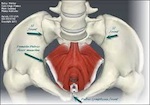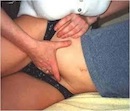Five things that pelvic health physical therapy can do to improve your endometriosis-related pain
By Sallie Sarrel PT, ATC, DPT
Pelvic health physical therapy is increasing in popularity among women with endometriosis. Pelvic health physical therapists are specially trained physical therapists that are critical members of the team treating your endometriosis.

Pelvic physical therapist, Sallie Sarrel
If your shoulder or knee hurts, you see a physical therapist to treat the bones, muscles, nerves, fascia, and ligaments for some relief. Similarly there are bones muscles, nerves, fascia, and ligaments in your pelvis and abdomen that experience substantial adaptations from the disease process of endometriosis.
Pelvic health or women’s health physical therapists work with the pelvis, spine, and abdomen. They evaluate the alignment, musculature, fascial systems, and movement patterns in the pelvis and body for issues that activate your pain and decrease your quality of life.
Then the pelvic health physical therapist develops a treatment programme customised to your specific needs. From alleviating pelvic floor dysfunction to improving your sex life, here are 5 things pelvic physical therapy can do for you:
1. Create a better pelvic floor
 The pelvis is lined with muscles called the pelvic floor.
The pelvis is lined with muscles called the pelvic floor.
The pelvic floor steadies the bony outlet of the pelvis, supports the organs of the pelvis, and stabilises connected joints like the hip and sacroiliac joint. The pelvic floor assists with faecal and urinary release and may aid in sexual performance like orgasm. The pelvic floor needs length to be able to accommodate pain free sex.
 The pelvic floor forms a sling shape that connects the front, back, and sidewall of the pelvis. The vagina, rectum, and urethra have muscular connections.
The pelvic floor forms a sling shape that connects the front, back, and sidewall of the pelvis. The vagina, rectum, and urethra have muscular connections.
So, any time you have a history of endometriosis the pelvic floor muscles respond to the presence of disease.
If the pelvic floor muscles cannot effectively coordinate contraction and relaxation of the pelvic floor it is called pelvic floor dysfunction. Symptoms of pelvic floor dysfunction include, but are not limited to:
- pain in the back, hips, and sacroiliac joint
- difficulty emptying the bladder
- urinary frequency, burning or pain
- constipation or diarrhea
- painful bowel movements and faecal incontinence
- painful sex
- inability to tolerate a speculum during a gynaecological exam, and
- pain with wearing tampons.
Pelvic health physical therapy helps you normalise pelvic floor dysfunction with a number of different interventions that will encourage you to re-coordinate the pelvic floor.
2. Help sex to be less painful

Trigger points
You are entitled to painless sex.
Endometriosis can make sex extremely painful. However, in order to experience less painful sex, it is important that the muscles inside the pelvic floor are elongated, not in shortened, and that nothing else in the pelvis is sending painful messages during sex.
It is proposed that endometriosis creates an environment of inflammation, scar tissue, and adhesions within the pelvic and abdominal cavity. These pelvic insults encourage the formation of myofascial trigger points within the pelvic floor, hip, and back muscles and abdomen. They also spasm and thicken the muscles inside the pelvis as they respond to the tension patterns the disease and surgery create.
Trigger points create connective tissue dysfunction and pain. Trigger points are known to have referred pain patterns, so whereas the trigger points may be inside the pelvis you may feel pain all the way down your leg or elsewhere in your body.
Cramping can increase pain from trigger points because pain patterns fire during the mechanical stressors of menstruation.
Even lack of flexibility of the hamstrings or hip flexor muscles or alignment problems in a joint can make sex, in any position, painful.
If you aren’t having sex because it’s painful, than becoming pregnant naturally is nearly impossible.
→ More about endometriosis and painful intercourse
3. Treat other causes of pain
With endometriosis, not all pelvic pain is endometriosis. Therefore, treating just the endometriosis may not provide you with the pain relief you need.
Known as the evil twins, it is not uncommon for women to have both interstitial cystitis (IC) and endometriosis. Interstitial cystitis, in addition to causing bladder symptoms, instigates pain in the pelvic floor, lower abdomen, back, and legs. IC may spasm the pelvis because the body is trying to protect itself from the pain and irritation.
Women with endometriosis can also experience vulvodynia and pudendal neuralgia – two pelvic pain disorders with multiple components including muscle and nerve impairments that pelvic health physical therapy can help relieve.
4. Attack that endo belly
 Many women with endometriosis complain of “endo belly” or excessive bloating for little or no reason.
Many women with endometriosis complain of “endo belly” or excessive bloating for little or no reason.
Some of this bloating can be attributed to the inflammatory peritoneal insults of endometriosis. However, tightness in the pelvic floor may contribute to “endo belly” because the floor cannot provide the support the way in which it was designed and thus the belly balloons out. The body is spasming as a protective response against endometriosis.
Physical therapy can help relax that protective response. It also can help work the lymphatic system and venous return to encourage inflammation to be absorbed. When the muscles in the abdomen, including the hip flexor muscle or psoas muscle, have trigger points or spasms you get outpouching which looks like extreme bloating.
Years of disease in the peritoneum and organs can cause the fascia, a plastic wrap like substance that is around everything in the body, and the brain to sense pain and proprioception (position) of the organs differently. Some pelvic health physical therapists perform a technique called “visceral manipulation therapy”. Women usually see a noticeable difference in the bloating and distention, as well as their abdominal and pelvic pain with visceral therapy.
5. Empower you
With the average diagnostic delay of seven years for women with endometriosis too many have suffered far too long without relief.
Some women have been told the pain is all in your head, or you wait for a doctor to fix you after so many treatment options fail.
Perhaps you are afraid to try just one more thing because it has been such a difficult journey? Don’t be afraid. The refreshing thing about pelvic health physical therapy is that you are the most important member of the treatment team. Success with physical therapy is a partnership between you and your therapist.
Many women are surprised the relief they feel from treating muscuskeletal issues contributing to their pain. Learning how connected the body is, and how endometriosis has affected everything from the nerves to the core muscles to their sex lives, is tremendously empowering.
Likewise having techniques to use when at home during a pain flare and having another professional in your corner reminds you that despite all the things that have happened to your body, you have influence over your own daily life. You are not you pain and you can get better!
See also
→ Endometriosis and painful intercourse
→ Glossary of medical terms
→ Other complementary therapies for endometriosis
→ Visceral manipulation as a technique to lessen abdominal adhesions
→ Preparing for pelvic physical therapy
The author
Sallie Sarrel PT, ATC, DPT is a pelvic health physical therapist in New York and New Jersey, USA. She has taken her own arduous battle with endometriosis to inspire women to empower themselves over pelvic pain. Her blog "Sallie Speaks" has received acclaim for its depiction of life with endometriosis. She frequently lectures worldwide on the value of pelvic physical therapy and endometriosis. She has a fervent belief that you are not your pain. Her patient-centered approach to physical therapy and endometriosis is unique. Contact for appointments in New York or New Jersey and for speaking engagements: www.salliesarrel.com






